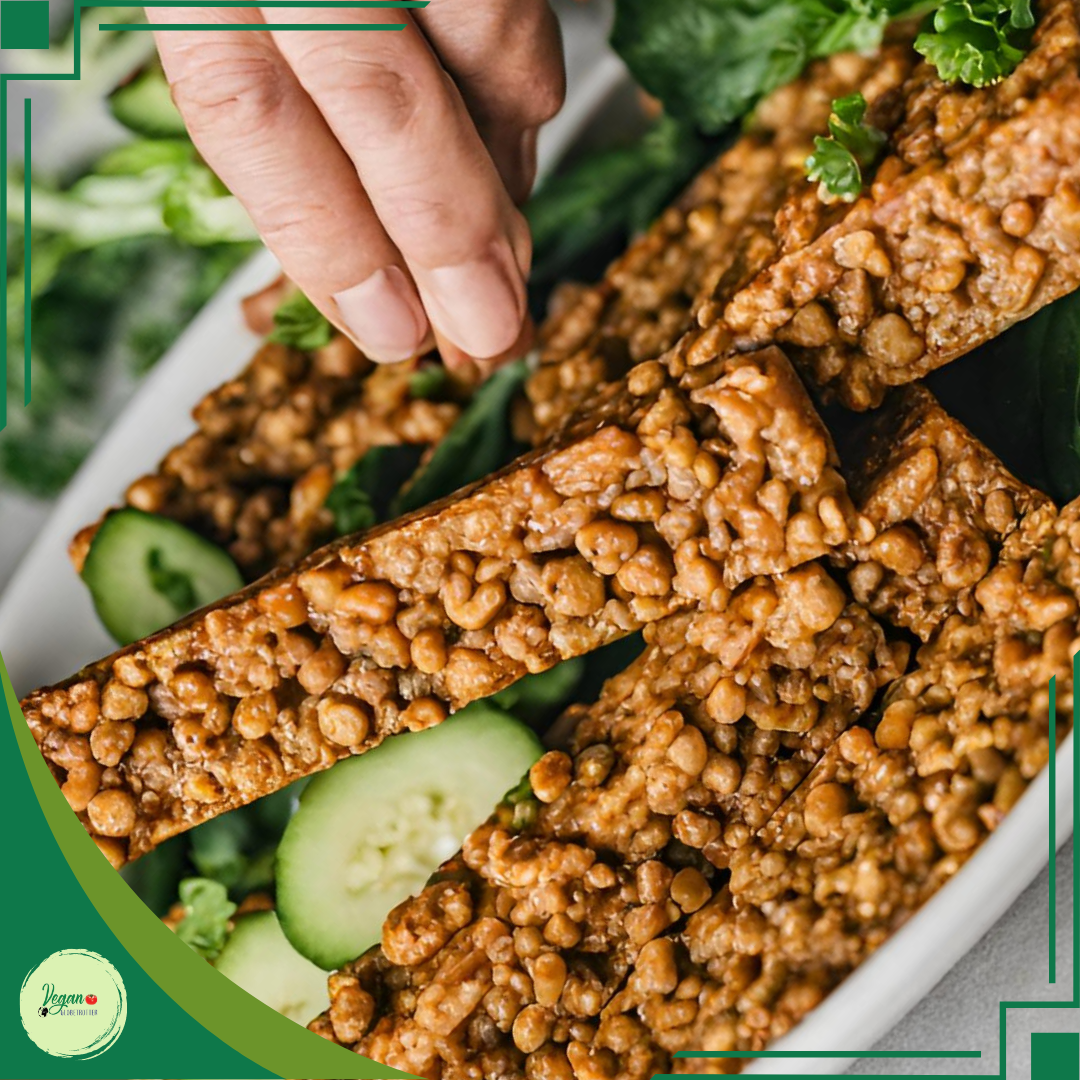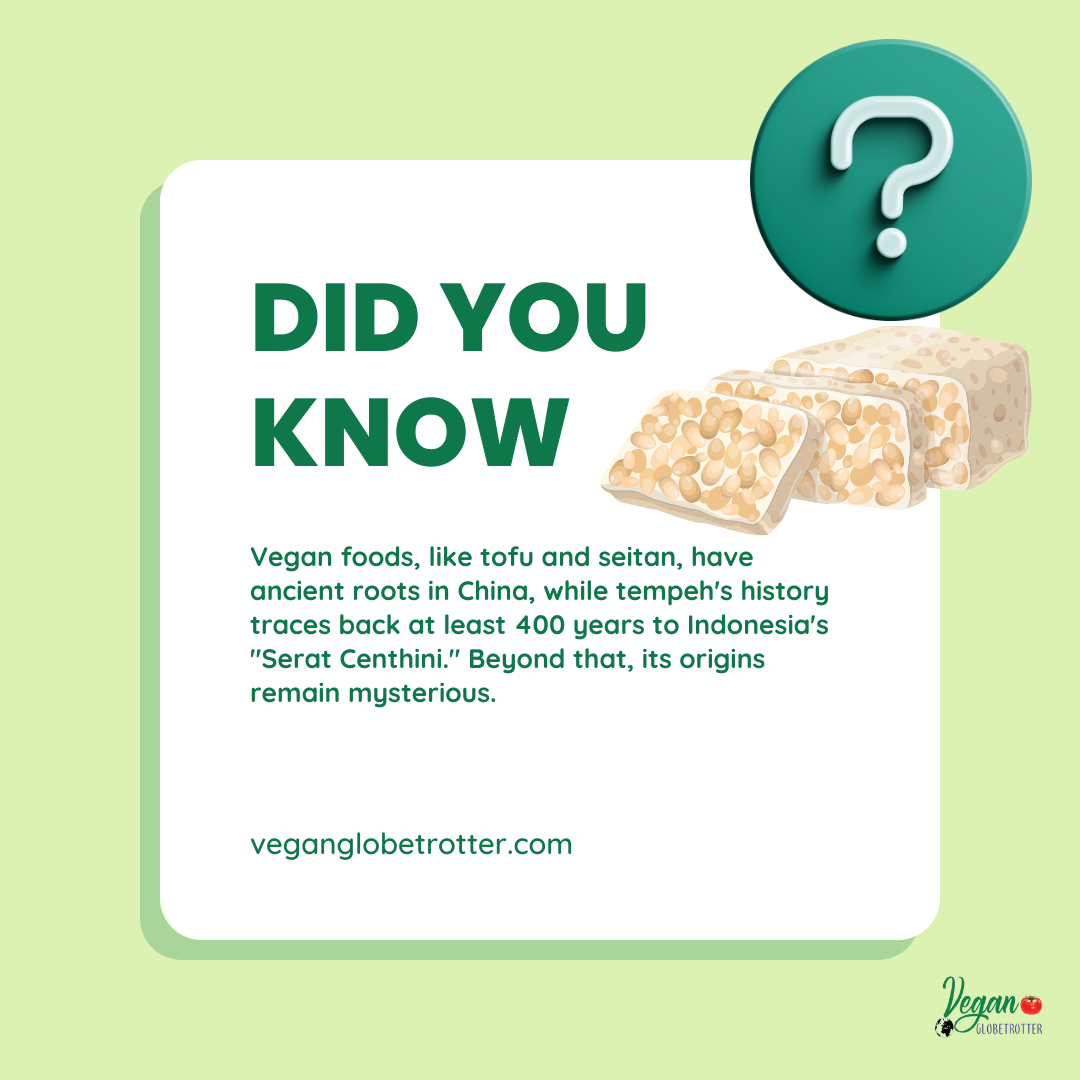Vegan Globetrotter is supported by our audience. When you purchase through one of our links, we may earn a small affiliate commission. As an Amazon Associate I earn from qualifying purchases. Your cost is not affected.
==================
Ah, tempeh. It’s not just a block of fermented soybeans but also a ticket to a world of flavor and versatility. It can be marinated, grilled, fried, or used as an ingredient in stews and chilis, making it a great meat alternative for vegetarian and vegan diets. Shopping and storage require some care, and consumers are advised to look for fresh tempeh and store it properly to maintain its quality and delicious flavor. As for its environmental impact, it is considered a more sustainable protein source than animal-based proteins, aligning with the growing interest in environmentally friendly eating habits.
Tempeh Unveiled: A Nutrient-Rich, Versatile, and Sustainable Plant-Based Protein
Discover tempeh: a versatile, plant-based protein originating from Indonesia. This fermented soy product offers a rich nutritional profile, culinary flexibility, and environmental sustainability, making it an ideal choice for vegetarian and vegan diets.

Key Takeaways
- Tempeh is a fermented soy product from Indonesia, known for its rich nutritional profile.
- It is easily incorporated into various recipes due to its ability to absorb flavors and its texture.
- As a sustainable plant-based protein source, tempeh offers environmental benefits over traditional meats.
What Is Tempeh?
Video Credit: @TheUrbanVeg
Tempeh is a delicious meat alternative offering a high-protein option for vegetarians and vegans. Moreover, it is a plant-based protein that has garnered attention for its versatility and benefits. This traditional food is made through fermentation that binds soybeans into a solid cake similar to a meaty texture.
Rich in protein, calcium, and iron, tempeh stands out for its nutty flavor and hearty texture, distinguishing itself from other soy-based products like tofu. It’s appreciated not only for its nutritional profile but also for its distinct taste in various dishes.

Definition and Origins
Tempeh is a traditional Indonesian food made by fermenting soybeans into a compact cake. It gained popularity in Southeast Asia before spreading globally as a valued component of plant-based diets.
Ingredients and Production
The production of tempeh involves the use of soybeans, which are soaked, dehulled, and partially cooked. A starter culture, typically Rhizopus Oligosporus, is then added to initiate fermentation. If the desired consistency of the mixture is achieved, it is then pressed into a mold, which binds into a dense, firm cake.
Nutritional Profile
Tempeh is celebrated not only for its versatility in the kitchen but also for its impressive nutritional content. It is rich in protein, dietary fiber, and vitamins such as B12, which are essential for a balanced diet. It provides many minerals, including calcium, magnesium, and iron, making it a highly nutritious food choice.

Health Benefits
Tempeh is not only good as a meat substitute, it also boasts several health benefits, including a robust protein profile, positive effects on digestive health, and serving as a wholesome plant based alternative in various diets.
- Protein Powerhouse: One of the standout features of tempeh is its high protein content. A 100-gram serving of tempeh typically provides around 18 grams of protein, making it an excellent protein source for vegetarians, vegans, and those looking to diversify their protein intake. The protein in tempeh is not only abundant but also easily digestible and rich in essential amino acids, contributing to muscle development and repair.
- Gut Health: Tempeh is a fermented food, which means it contains beneficial bacteria that can positively impact gut health. During the fermentation process, soybeans are inoculated with the fungus Rhizopus oligosporus, producing probiotics. These probiotics contribute to a healthy gut microbiome, promoting digestion, nutrient absorption, and overall digestive well-being.
- Heart Health: Consuming tempeh may contribute to heart health due to its favorable fatty acid profile. Unlike some other soy products, tempeh is low in saturated fat and contains a good amount of polyunsaturated fats, including omega-3 fatty acids. These heart-healthy fats are associated with a reduced risk of cardiovascular diseases.
- Bone Health: Tempeh is a good source of calcium and phosphorus, essential minerals for maintaining strong and healthy bones. This can be particularly beneficial for individuals following a plant-based diet that may be lacking in these minerals.
Protein Content
Tempeh is a valuable source of protein, particularly appealing to vegetarians and vegans. It contains all the essential amino acids, making it a complete protein. This characteristic is vital for muscle growth, repair, and overall bodily function.
Digestive Health
The fermentation process of tempeh produces natural prebiotics, which are beneficial for the digestive system. These prebiotics help maintain a healthy balance of gut flora, thereby improving gut health and potentially aiding digestion and nutrient absorption.
Plant-Based Alternative
As a plant-based meat substitute, tempeh not only replicates the texture of meat but also serves as a nutritious alternative. It’s a versatile ingredient that can be incorporated into various dishes, helping individuals reduce their meat consumption while enjoying satisfying meals.
Culinary Uses
Tempeh is a versatile ingredient that can be prepared and enjoyed in numerous ways as a plant-based meal suited to various dietary preferences and cultural cuisines. Beyond its health benefits, its versatility in the kitchen makes it a favorite among chefs and home cooks alike who experiment with the best tempeh recipes.

Preparation Methods
There are various meal preps when you cook tempeh. One can first choose to steam, boil, or sauté to soften it, which can also reduce its natural bitterness. Marinating it is a common practice, as it absorbs flavors well, making it a perfect candidate for bold and rich sauces. For a crunchy texture, it can be fried or baked until it achieves a golden-brown crust.
Recipe Ideas
- Marinated and Grilled Tempeh Skewers – Marinate tempeh before grilling, as it imparts depth and flavor. Create a marinade with soy sauce, garlic, ginger, and your favorite fresh herbs. Skewer the marinated tempeh and grill to perfection. The result? A savory and protein-packed appetizer or main course.
- Tempeh Stir-Fry with Fresh Vegetables – Tempeh’s firm texture makes it an ideal candidate for stir fries. Cut into bite-sized pieces, toss with an array of colorful vegetables, and stir fry in a flavorful sauce made from soy sauce, sesame oil, or olive oil, and a hint of maple syrup. Serve over white rice, brown rice, or noodles for a quick and satisfying meal.
- Crispy Tempeh Tacos – Transform vegan tempeh into a Tex-Mex delight by crumbing and pan-frying it until golden brown. Fill taco shells with the crispy tempeh, and add your favorite toppings like shredded lettuce, diced tomatoes, avocado, and a drizzle of creamy sauce for a delightful twist on traditional tacos.
- Tempeh and Vegetable Curry – Infuse tempeh with the exotic flavors of a rich and aromatic curry. Simmer tempeh cubes in a coconut milk-based curry sauce with various vegetables and spices. The result is a hearty and satisfying curry that pairs perfectly with rice or flatbread.
- Tempeh Bacon for Breakfast – Are you craving a plant-based alternative to bacon? Marinate with thin slices of tempeh in a smoky mixture of soy sauce, liquid smoke, and maple syrup, then pan-fry until crispy. Enjoy tempeh bacon alongside your morning favorites for a flavorful and protein-packed breakfast.
- Tempeh Salad Bowls – Tempeh’s nutty flavor and substantial texture make it an excellent addition to salads. Cube or crumbled tempeh over a bed of fresh greens, add colorful vegetables, and drizzle with your favorite dressing for a wholesome and satisfying salad bowl.
Cultural Significance
Tempeh is important in Indonesian culture as a staple protein source. It is celebrated for its nutritional value and cultural heritage, playing a prominent role in Indonesian recipes and local diets. Similarly, it has become an integral ingredient for those seeking plant-based proteins in Western cuisine, carving out its niche in vegetarian and vegan cooking.
Selection and Storage
Selecting high-quality tempeh and storing it properly is essential to maintaining its freshness and extending its shelf life. Proper techniques can enhance the taste and nutritional benefits of this fermented soy product.

Choosing Quality Tempeh
When you buy tempeh in health food stores, you should look for products with a firm texture and a uniform white color, which indicates proper fermentation. It is important to check the expiration date and opt for tempeh made from non-GMO soybeans, which is available in most grocery stores. Packaging should be intact, with no signs of damage or tampering.
Storage Recommendations
To maximize the shelf life of store-bought tempeh, it should be kept refrigerated. Unopened tempeh can be stored in the refrigerator until the sell-by date. Once opened, consuming it within 5-7 days is advisable.
During this time, keeping it in an airtight container is recommended. For longer storage, it can be frozen for up to three months. Thawing should be done in the refrigerator before use.
Environmental Impact
Tempeh is emerging as an environmentally friendly choice due to its low resource demand in production compared to animal-based proteins.
Sustainability Considerations
- Land Use – Tempeh production is efficient in terms of land use. Since it’s derived from fermented soybeans, it utilizes less land than traditional livestock farming. According to Treehugger, tempeh’s land requirements are significantly lower, allowing for more sustainable land management practices.
- Water Consumption – It requires a fraction of the water for raising animals. This significant reduction in water use contributes to its sustainability profile, especially in regions where water scarcity is a concern.
- Greenhouse Gas Emissions – The carbon footprint of tempeh is notably lower. Producing 1 kilogram of tempeh emits drastically less CO2 compared to beef, as Greener Ideal reports.
- Energy Efficiency – Its production process is generally less energy-intensive than meat-based snacks, reinforcing its position as an eco-friendly alternative highlighted on Thips.com.
These points articulate why tempeh is considered a more sustainable food option, emphasizing the potential benefits of integrating it into diets for those concerned with environmental impacts.
Wrapping It Up
Tempeh is a nutritional powerhouse. Rich in protein, fiber, and vitamins, it’s great for any diet. Versatile in recipes, it’s easy to cook with.

Remember, adding it to your meals boosts health benefits. Explore and enjoy the diverse flavors it brings to the table!
Frequently Asked Questions
What are the health benefits of consuming tempeh?
Tempeh is loaded with healthy nutrients, including a high protein content, prebiotics, and various vitamins and minerals. Its fermentation process also makes it beneficial for digestive health.
How does tempeh differ in taste from other meat substitutes?
Compared to other meat substitutes, it has a distinct nutty, earthy flavor and a chewy texture that sets it apart. The fermentation process it undergoes contributes to its unique taste profile.
Can individuals with gluten intolerance safely eat tempeh?
Most tempeh is gluten-free, but one should always check product labels, as some varieties may contain added grains that have gluten. It’s crucial for those with gluten intolerance to verify the ingredients.
What are some simple tempeh recipes for those new to cooking it?
For novices, simple ways to prepare tempeh is to grill, bake, or stir fry. One can start with basic recipes such as marinated tempeh that allow the natural flavors to shine through.
Is it true that tempeh is a suitable protein source for vegans?
Yes, it serves as an excellent protein source for vegans, supplying both the necessary amino acids and nutrients required for a balanced diet.
How does tempeh compare to tofu in terms of nutritional value?
It generally offers more protein and fiber than tofu and is a whole food as it retains all parts of the soybean. Its nutrient profile is considered superior due to the fermentation process it undergoes.
Learn Vegan Cooking With Us!
Discover the various vegan dishes with Vegan Globetrotter. Learn aromatic and appetizing vegan dishes that blend flavor, health, and simplicity. Stay connected and enhance your vegan cooking skills:
- Facebook: Vegan Globetrotter
- Instagram: @_veganglobetrotter
- Pinterest: The Vegan Globetrotter
- Twitter: @VeganGlobetrot
Join our community and explore the wonders of vegan cooking! For more insights into the world of vegan cooking, visit our website: veganglobetrotter.com



Don't miss out
when new recipes and information are added!
Join our newsletter for free recipes,
healthy living inspiration, and special offers
You have Successfully Subscribed!